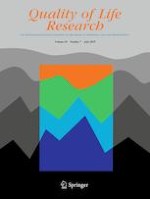18-02-2019
Comparison of EQ-5D-5L and SPVU-5D for measuring quality of life in patients with venous leg ulcers in an Australian setting
Gepubliceerd in: Quality of Life Research | Uitgave 7/2019
Log in om toegang te krijgenAbstract
Purpose
Given the importance of measuring health-related quality of life (HRQoL) for cost–utility studies, this study aimed to determine the validity and responsiveness of two preference-based HRQoL instruments, the EuroQol-five dimensions-five levels questionnaire (EQ-5D-5L) and the Sheffield Preference-based Venous Ulcer questionnaire (SPVU-5D) in patients with venous leg ulcers (VLUs) in an Australian setting.
Methods
This study analysed de-identified data collected from 80 patients with VLUs recruited by a prospective study in Brisbane, Queensland, Australia. Patients were asked to complete EQ-5D-5L and SPVU-5D surveys at baseline, 1-month, 3-month and 6-month follow-up as part of the prospective study. Baseline data and follow-up data were pooled to test the construct validity and level of agreement of the two instruments. Follow-up data were used to test the responsiveness.
Results
The ceiling effects were negligible for EQ-5D-5L and SPVU-5D utility scores. Both instruments were able to discriminate between healed VLU and unhealed VLU and showed great responsiveness when healing status changed over time. Weak to strong correlations were found between dimensions of EQ-5D-5L and SPVU-5D. The utility scores produced from EQ-5D-5L were generally lower.
Conclusions
This study found that both EQ-5D-5L and SPVU-5D were valid and responsive in detecting change of VLU healing status among a small Australian population. Both instruments may be used in economic evaluation studies that involve patients with healed or unhealed VLUs. However, given the limitations presented in this study, further research is necessary to make sound recommendations on the preferred instrument in economic evaluation of VLU-related interventions.
